11 Common Types of Trees in South Carolina (with Pictures)
-

- Last updated:

Sitting on the fringe of the transition zone, South Carolina is uniquely suited for a variety of thriving plant life. Trees are a prominent feature in the landscape, and a broad climate range allows for an even more diverse selection of specimens.
From the coast to the mountains, unique tree varieties abound in every corner of the state. Learn all about the unique majesty of the area with this look at 11 common types of trees in South Carolina.

The 11 Common Types of Trees in South Carolina
1. Red Maple

| Sun and Soil: | Full; moist, rich |
| Height: | 40–60 feet |
| Spread: | 40 feet |
The red maple (Acer rubrum) is a stunning statement on the lawn as fall arrives. Leaves can grow as long as 6 inches, providing year-round interest as they transition from lush greens to striking reds and yellows.
As a shade tree, the red maple has a beneficially speedy growth rate and dense spread at maturity. It has some drought tolerance and can survive in varied soil conditions. The best growth occurs in moist, loamy soil with full sunlight.
2. Pin Oak
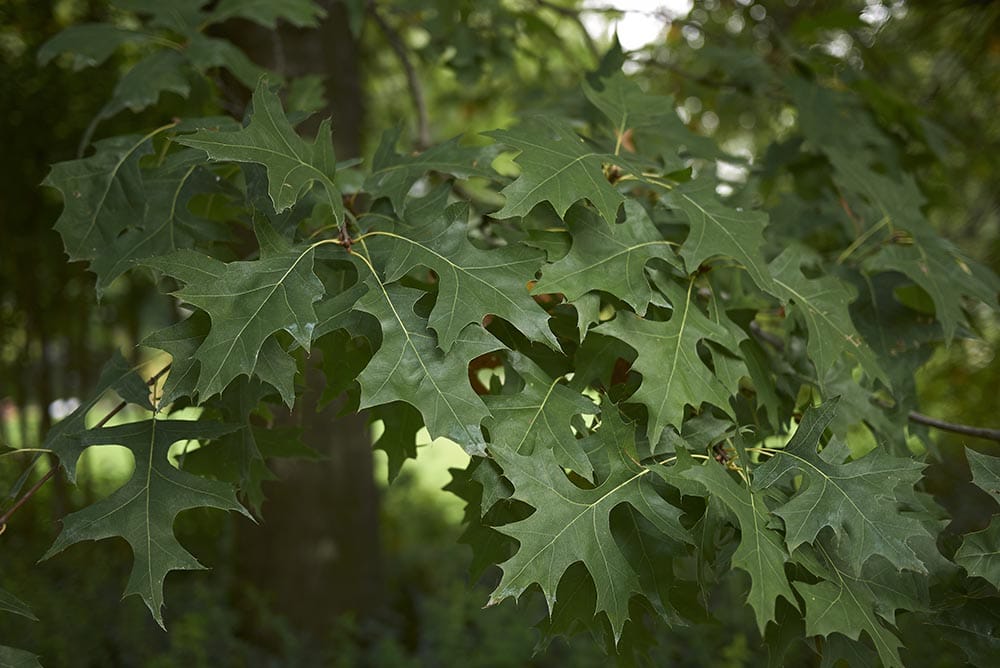
| Sun and Soil: | Full; moist, rich |
| Height: | 60–70 feet |
| Spread: | 25–40 feet |
Since it’s fast-growing yet solid, the pin oak (Quercus palustris) is a handsome tree from every angle. A strong and elegant central leader manages horizontal branches for a dignified, symmetrical form. Glossy green foliage fills the slender twigs to form a clean pyramidal shape with a fantastic shade cover. Leaves change to subtle, alluring shades of red, burnt orange, and yellow in the fall.
The pin oak is a desirable landscaping tree. It’s surprisingly resilient despite its fast growth rate, a rare trait for an oak variety, and it lends itself well to transplanting due to a shallow root system. Also called the swamp oak, it’s tolerant of wet conditions, preferring nutrient-rich, acidic soil with plenty of moisture.
3. Cabbage Palmetto
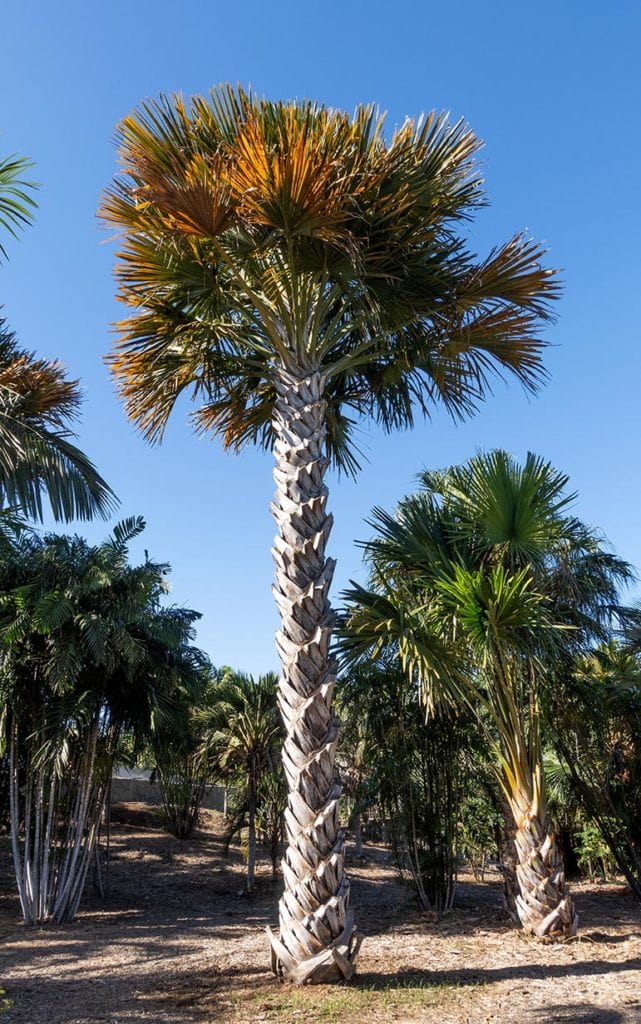
| Sun and Soil: | Full; moist, well-drained |
| Height: | 40–60 feet |
| Spread: | 10–15 feet |
Nothing says “South Carolina” like the cabbage palmetto (Sabal palmetto), the state’s official tree since 1939. The tree has a distinct tropical flair due to its fan-shaped leaves and shedding stalk. It’s uniquely beautiful and sturdy and is a favored street tree that stands its ground even in the harshest coastal storms.
Cabbage palms make an attractive addition to the yard, especially when the grand, showy flowers arrive in the summer. Shiny black fruits follow soon after to add even more interest. The tree grows well in sun or partial shade and is fairly drought-tolerant when established. If you figure out the relatively tricky transplanting process, it is an easy plant to grow.
4. Sassafras
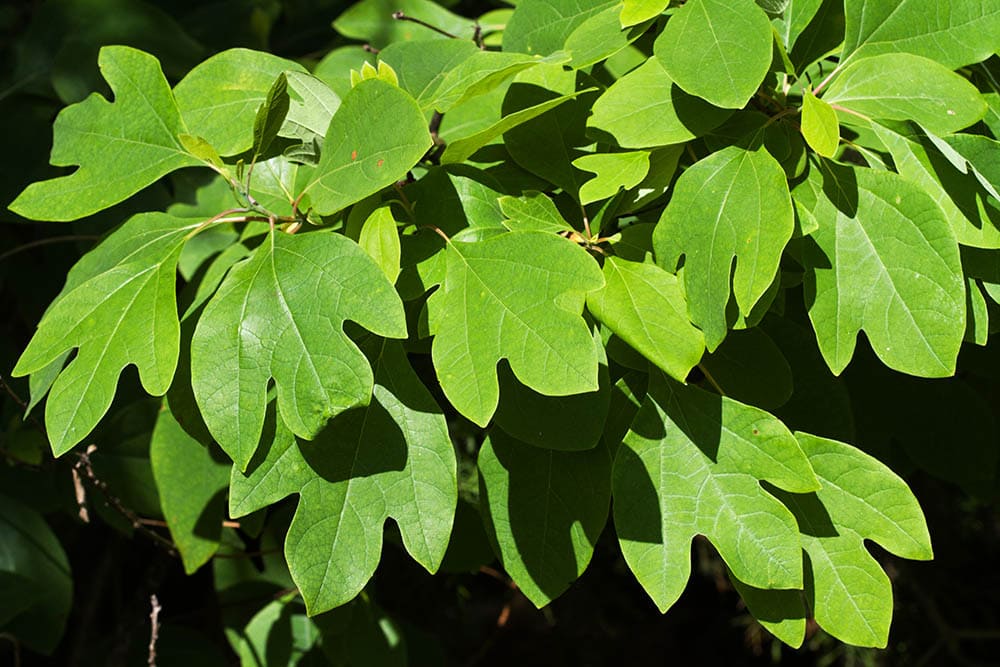
| Sun and Soil: | Full; moist, well-drained |
| Height: | 30–60 feet |
| Spread: | 25–40 feet |
Sassafras (Sassafras albidum) presents fascinating foliage throughout its irregular pyramidal form. Leaves consist of one to three lobes and stay bright green through the summer before turning striking shades of scarlet, orange, and yellow. All sassafras trees feature yellow flowers in spring, but only females develop dark blue berries in the summer, attracting various local birds and mammals.
With its deep taproot, a sassafras tree isn’t the most straightforward specimen to transplant, but you may have luck with propagation. It tolerates most soil types and faces few pest or disease issues.
5. American Beech
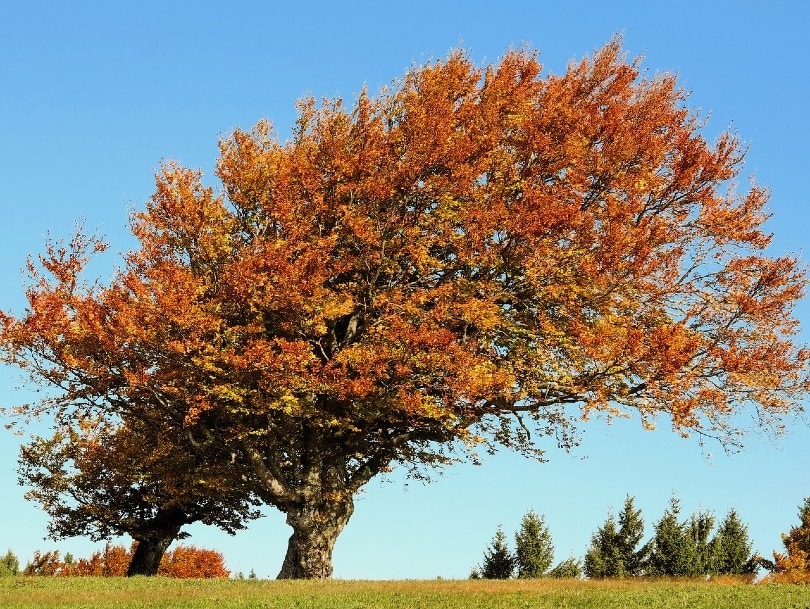
| Sun and Soil: | Full/partial; deep, well-drained |
| Height: | 50–80 feet |
| Spread: | 40–80 feet |
The American beech (Fagus grandifolia) is a glorious South Carolina tree. It’s a tall species with a short trunk and stretching branches that fill the air with a dense waterfall of foliage. Serrated shiny green leaves turn bronze and gold hues as the seasons change and stay on the tree through much of the winter for an enduring display of color.
As a low-maintenance tree, the American beech is a lovely specimen if you have the space to accommodate it. The sturdy structure demands deep, well-drained soils. Otherwise, it’s an easy-going species. It grows well in varying ground conditions and can tolerate partial shade, though its dominating form makes sun exposure a rare issue.
6. Loblolly Pine
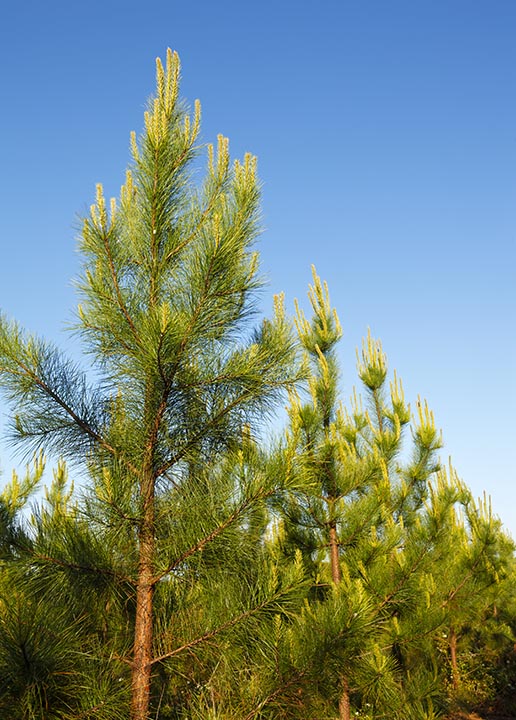
| Sun and Soil: | Full; moist, poorly drained |
| Height: | 40–80 feet |
| Spread: | 20–40 feet |
As one of the straightest and fastest-growing pines, the loblolly pine (Pinus taeda) is a critical commercial tree for lumber and pulp. Fragrant needles grow as long as 10 inches, popping up in groups of three. The trees lose their lower branches as they age, forming a rounded crown.
Loblolly pines don’t make exceptional specimens but grow well in groups. Use them as a windscreen, and you’ll benefit from the low maintenance demands and speedy growth. It thrives in full sun and wet soils, preferring slower drainage than most trees.
7. Tulip Poplar
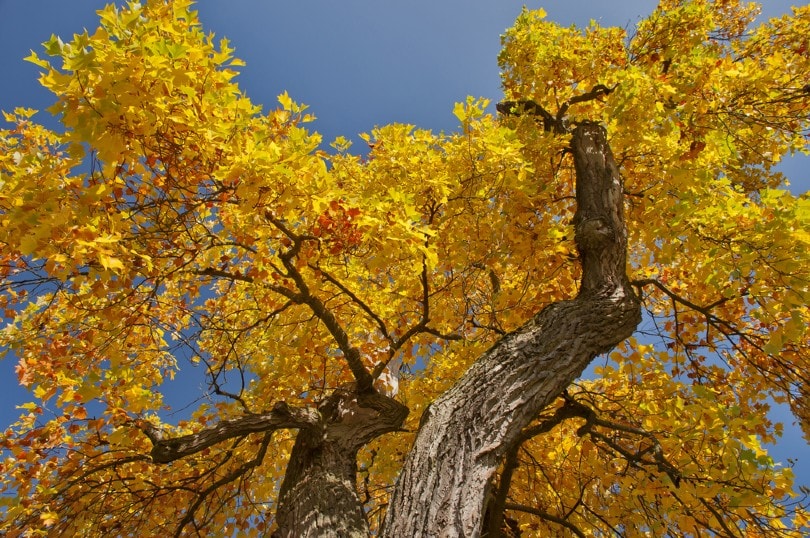
| Sun and Soil: | Full; rich, moist, well-drained |
| Height: | 70–90 feet |
| Spread: | 30–40 feet |
The prized tulip poplar (Liriodendron tulipifera) is one of the most magnificent American hardwoods. The deciduous tree can grow well over 100 feet tall, forming a narrow oval shape defined by star-shaped green leaves that warm to a glowing yellow in the fall.
Spring blooms are astonishing. The tulip-shaped flowers take on showy shades of orange, green, and yellow that are unfortunately easy to miss, given their preference for growing further up the tree.
8. American Holly
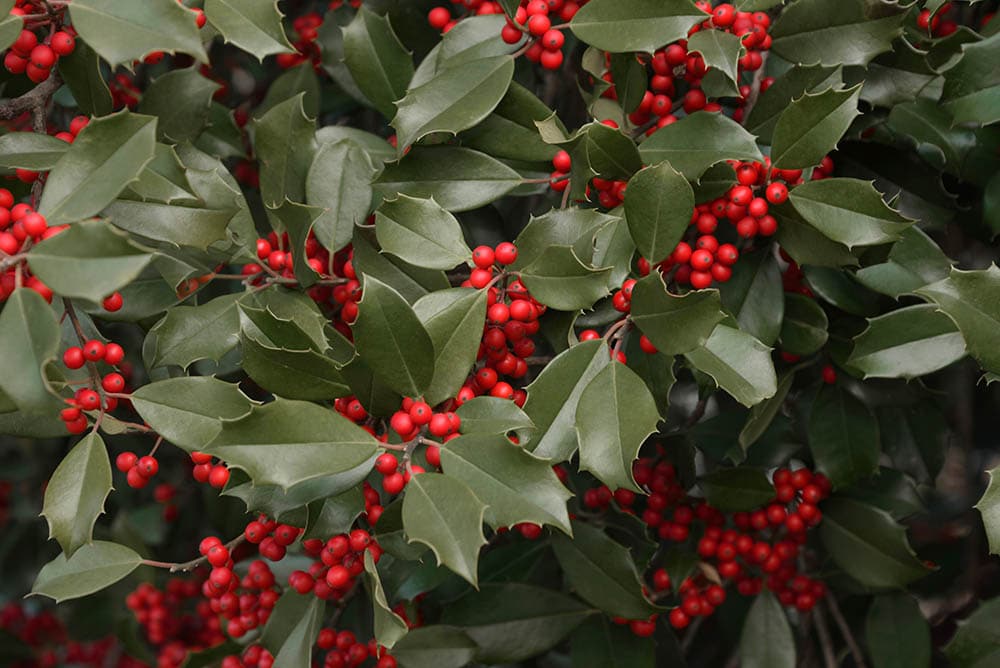
| Sun and Soil: | Partial; Moist, well-drained |
| Height: | 40–50 feet |
| Spread: | 18–40 feet |
The American holly (Ilex opaca) is a classic ornamental species that maintains its glossy green foliage year-round. Though often shaped into a hedge, it can grow into a pyramidal tree up to 50 feet tall. Dazzling eruptions of brilliant red berries make the tree a spectacular specimen and an essential aid for various wildlife.
American holly is a delightful decoration but often requires a careful touch. It prefers shade during the hottest hours in South Carolina climates, and well-drained soil is a must. It’s also susceptible to numerous pests and diseases, including spider mites, powdery mildew, whiteflies, and leaf spots.
9. Sycamore
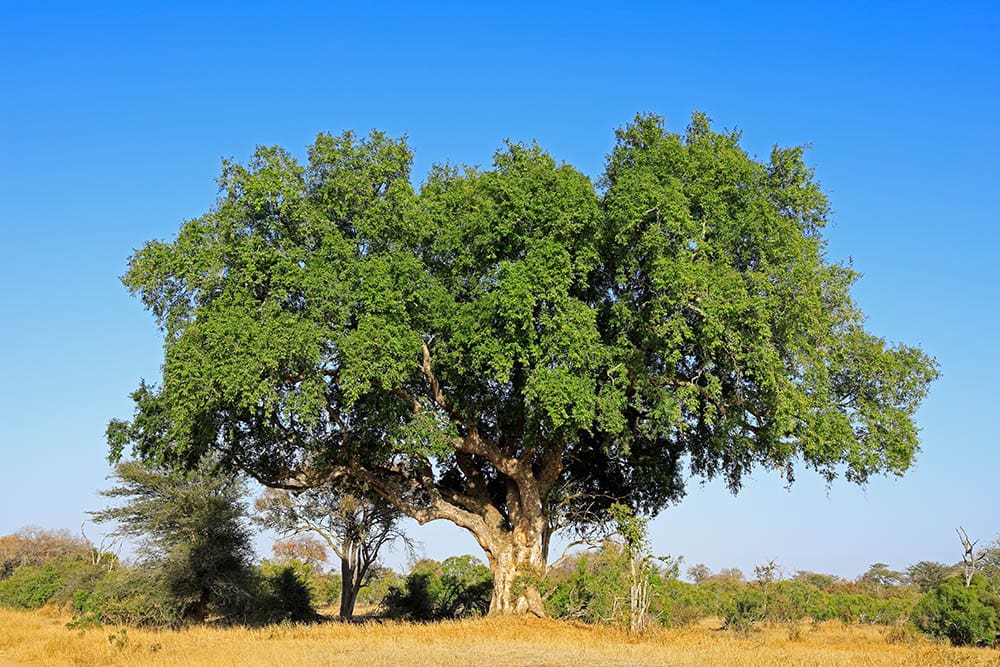
| Sun and Soil: | Full; rich, moist, well-drained |
| Height: | 70–100 feet |
| Spread: | 70–100 feet |
Another fast-growing deciduous tree is the American sycamore (Platanus occidentalis), which supplies one of the more unique aesthetics among shade trees. The medium-toned green foliage transitions to attractive warm colors in the fall, but the true highlight is the bark. The bark flakes to create a stark contrast between its medium gray-brown tones and the fresh white wood underneath.
The towering stature makes the sycamore an unlikely candidate for a landscaping feature. They’ll commonly grow in open areas such as parks or near streams. Sycamores are prone to numerous pests and fungal attacks, often leaving them hollow and worn out.
10. Sweetgum
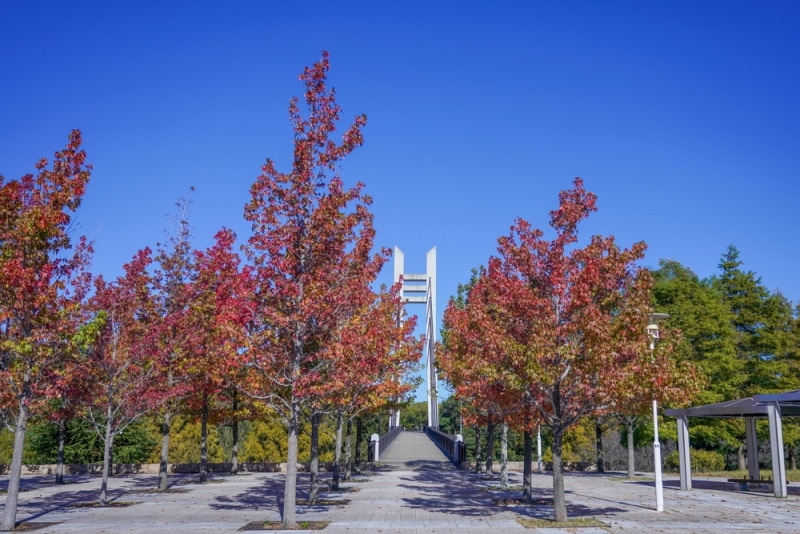
| Sun and Soil: | Full; acidic, moist, well-drained |
| Height: | 60–75 feet |
| Spread: | 40–50 feet |
The deciduous American sweetgum (Liquidambar styraciflua) is a tall-growing tree distinguishable by its star-shaped leaves. Fall colors are a delight, as the lustrous green switches to deep purple and red hues, creating a vibrant focal point in the yard.
Sweetgum trees are generally easy to grow, flourishing if they receive full sun and loamy, well-drained soil. Although they don’t tolerate pollution, they can withstand moderate drought and don’t have any notable disease or pest problems.
11. Blackjack Oak
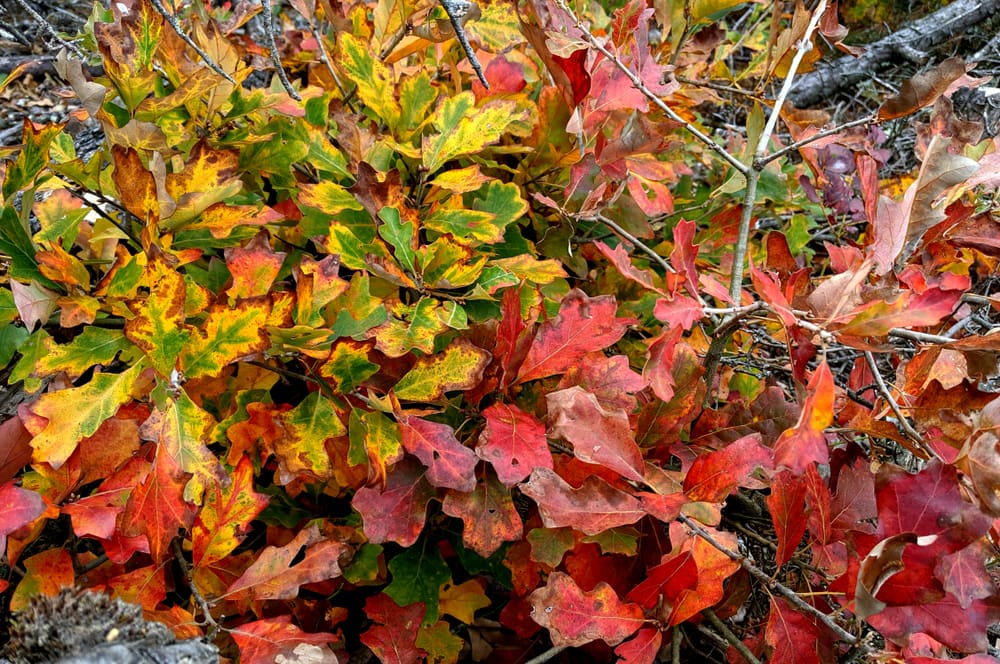
| Sun and Soil: | Full; average, well-drained |
| Height: | 50–75 feet |
| Spread: | 40–70 feet |
With its irregular branching, dark trunk, and bristle-tipped leaves, the slow-growing blackjack oak (Quercus marilandica) exhibits an intriguing character. In the fall, the dark green foliage takes on splotchy dashes of crimson, supplying eye-catching gradients of contrasting color.
Blackjack oak trees are not common in landscaping. With a preference for dryer soil conditions, they often fill barren areas where other trees fail to grow.

Conclusion
South Carolina doesn’t cover a wide area, but there’s no shortage of gorgeous landscapes highlighted by diverse assortments of trees. A vast supply of cultivars allows creative gardeners to bring these natural wonders home. Some require a lighter touch than others to work in the yard, but with careful selection, it can be easy to make a powerful statement.
See also:
- 10 Types of Black Birds in South Carolina (with Pictures)
- 10 Wildflowers Native to South Carolina (Identification Guide With Pictures)
Featured Image Credit: Bachy, Pixabay
Contents
